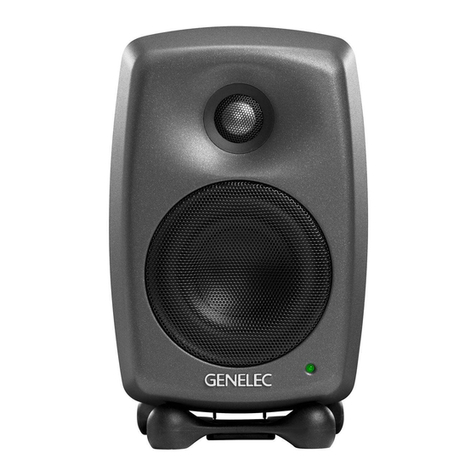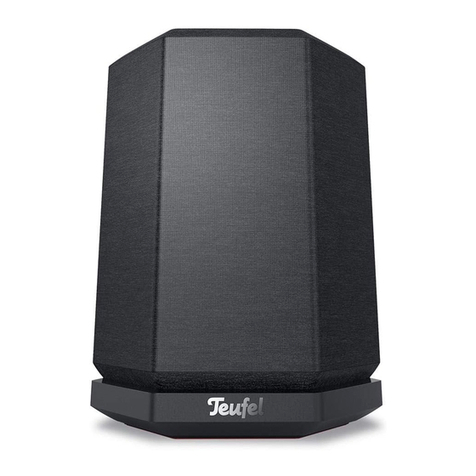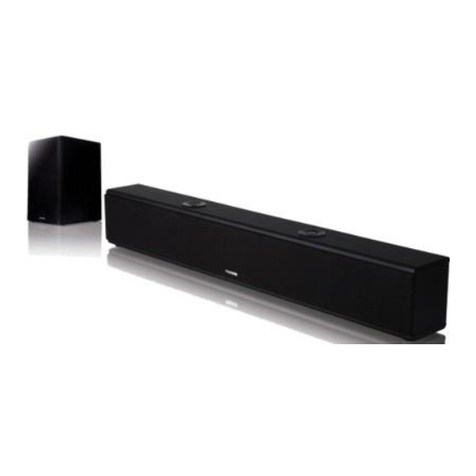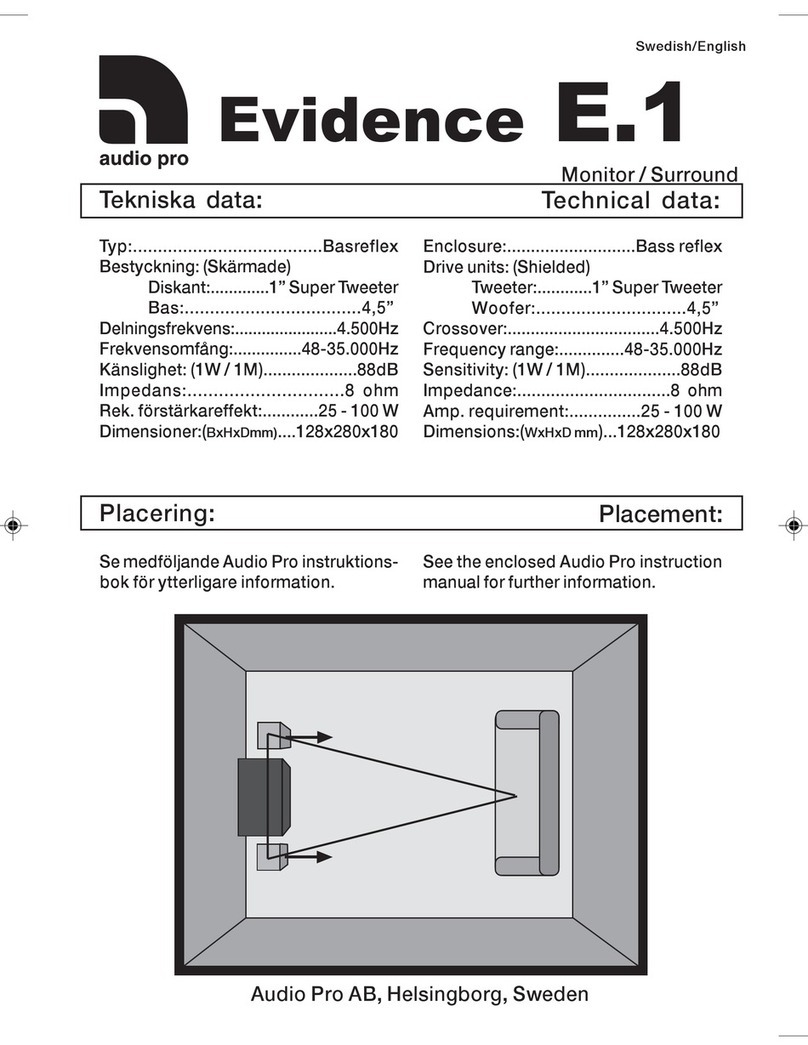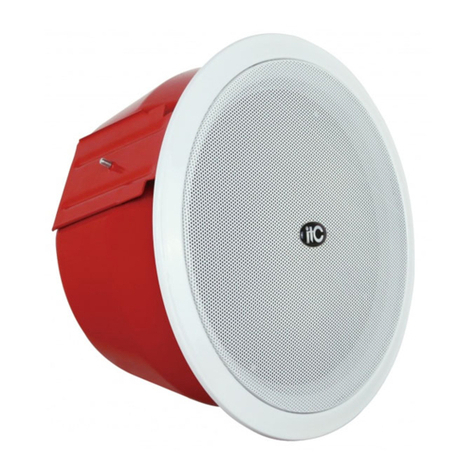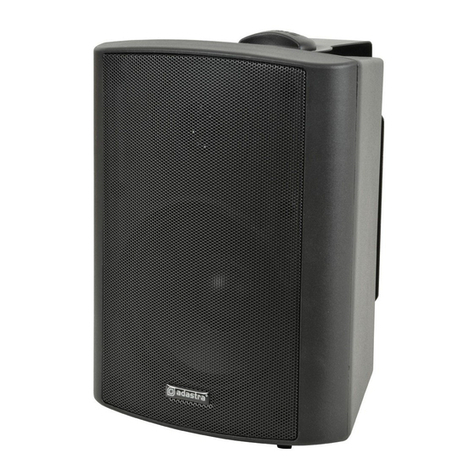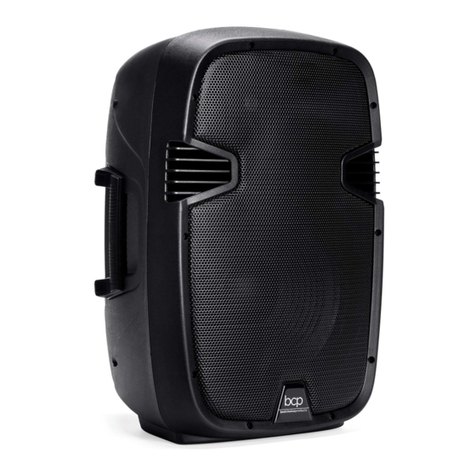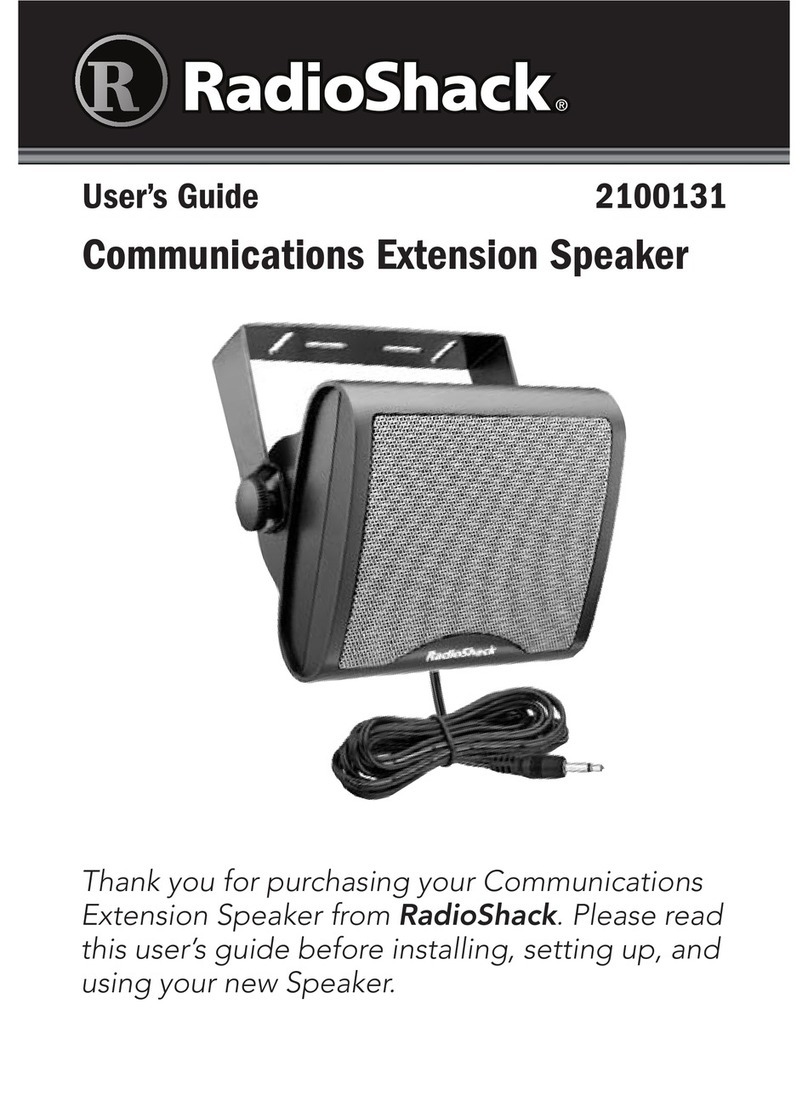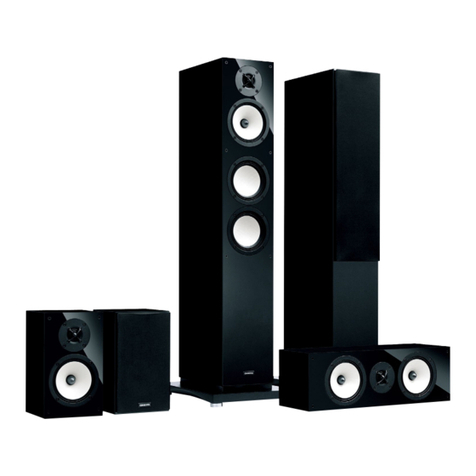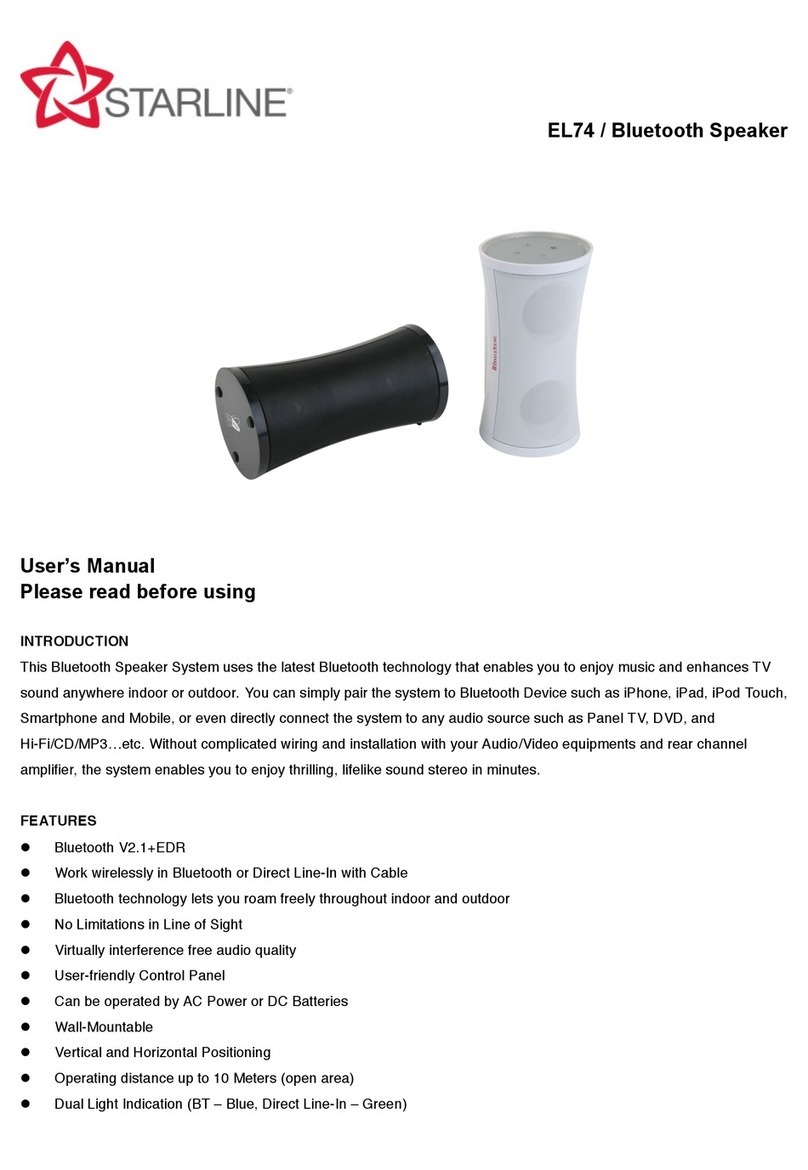Genelec 8030B User manual

8030B
Operating Manual 2-7
Betriebsanleitung 8-13
Manuel d’utilisation 14-19
Käyttöohje 20-25
Bruksanvisning 26-31

2 English
General description
The bi-amplified GENELEC 8030B is a two way
active monitoring loudspeaker designed to be small
but still have high output, low coloration, and broad
bandwidth.
The 8030B is ideal for near field monitoring,
mobile vans, broadcast and TV control rooms, sur-
round sound systems, home studios, multimedia
applications and also for use with computer sound-
cards. As an active loudspeaker, it contains driv-
ers, power amplifiers, active crossover filters and
protection circuitry. The MDE™ (Minimum Diffrac-
tion Enclosure™) loudspeaker enclosure is made
of die-cast aluminium and shaped to reduce edge
diffraction. Combined with the advanced Direc-
tivity Control WaveguideTM (DCWTM), this design
provides excellent frequency balance in difficult
acoustic environments. If necessary, the bass
response of the 8030B’s can be extended with a
suitable Genelec subwoofer.
Positioning the loudspeaker
Each 8030B monitor is supplied with an inte-
grated amplifier unit, mains cable and an operating
manual. After unpacking, place the loudspeaker in
its required listening position, taking note of the line
of the acoustic axis. The axes of all loudspeakers
should converge at ear height at the listening position
(see Figure 1).
Connections
Before connecting up, ensure that the mains
switch is off and the volume control fully counter-
clockwise. These controls are located on the front
panel of the loudspeaker. Do not connect the loud-
speaker to an unearthed mains supply or using an
unearthed mains cable.
Audio input is via a 10 kOhm balanced female
XLR connector labelled “INPUT”. An unbalanced
source may be used as long as pin 3 is grounded
to pin 1 at the unbalanced source connector (see
Figure 2).
The male XLR “OUTPUT” connector can be
used for daisy-chaining up to six 8030B’s together
or for connecting a Genelec 7050B subwoofer.The
volume control attenuates the signal on this output,
so the first “master” loudspeaker on a daisy-chain
can be used to adjust the level on the whole chain.
The volume controls on the “slave” loudspeakers
should be set fully clockwise.
Once the connections have been made, the
loudspeakers are ready to be switched on.
Autostart function
The signal sensing Autostart function of the loud-
speakers powers them up when playback begins.
Automatic powering down of the loudspeakers
happens one hour after the playback has ended
and the loudspeakers go to standby mode. The
power consumption in standby mode is less than
8030B
Active Monitoring System

English 3
0.5 watts. The loudspeakers will automatically and
rapidly start once an input signal is detected from
the source.
Setting the volume control
The input sensitivity of the loudspeaker can be
matched to the output of the audio signal source by
adjusting the volume control on the front panel.
Setting the tone controls
The frequency response of Genelec 8030B can
be adjusted to match the acoustic environment by
setting the tone control switches on the rear panel.
The controls are “Treble Tilt”, “Bass Tilt” and “Bass
Roll-Off”. An acoustic measuring system such as
WinMLS is recommended for analyzing the effects
of the adjustments, however, careful listening with
suitable test recordings can also lead to good
results if a test system is not available. Table 1
shows some typical settings in various situations.
Figure 4 shows the effect of the controls on the
anechoic response.
Treble Tilt
Treble Tilt (switch 1) attenuates the treble response
above 5 kHz by 2 dB, which can be used for smooth-
ening down an excessively bright sounding system.
Bass Tilt
Bass Tilt offers three attenuation levels for the bass
response below 1 kHz, usually necessary when the
loudspeakers are placed near room boundaries.
The attenuation levels are -2 dB (switch 3 “ON”), -4
dB (switch 4 “ON”) and -6 dB (both switches “ON”).
Figure 1: Location of the acoustic
axis
Figure 2: Type of cable needed if
unbalanced source is used (ex-
ample shown is RCA output to the
XLR input)
Figure 3: Control and connector layout on the rear panel of
the 8030B.
190 mm
ACOUSTIC
AXIS
> 0,7 m

4 English
Bass Roll-Off
Bass Roll-Off (switch 2) activates high-pass filter-
ing at 85 Hz to complement the low-pass filter on a
Genelec 7050 subwoofer.This switch should always
be set to “ON” when using the 8030B with a 7050
subwoofer.
The factory setting for all tone controls is “OFF” to
give a flat anechoic response. Always start adjust-
ment by setting all switches to “OFF” position. Mea-
sure or listen systematically through the different
combinations of settings to find the best frequency
balance.
Mounting considerations
Align the loudspeakers correctly
Always place the loudspeakers so that their acous-
tic axes (see figure 1) are aimed towards the listen-
ing position. Vertical placement is preferable, as it
minimises acoustical cancellation problems around
the crossover frequency.
Maintain symmetry
Check that the loudspeakers are placed symmetri-
cally and at an equal distance from the listening
position. If possible, place the system so that the lis-
tening position is on the centerline of the room and
the loudspeakers are placed at an equal distance
from the centerline.
Minimise reflections
Acoustic reflections from objects close to the loud-
speakers like desks, cabinets, computer monitors
etc. can cause unwanted blurring of the sound
image.These can be minimised by placing the loud-
speaker clear of reflective surfaces. For instance,
putting the loudspeakers on stands behind and
above the mixing console usually gives a better
result than placing them on the meter bridge.
Minimum clearances
S
ufficient cooling for the amplifier and function-
ing of the reflex port must be ensured if the loud-
speaker is installed in a restricted space such as a
cabinet or integrated into a wall structure. The sur-
roundings of the loudspeaker must always be open
to the listening room with a minimum clearance of 5
centimeters (2”) behind, above and on both sides of
the loudspeaker. The space adjacent to the ampli-
fier must either be ventilated or sufficiently large
to dissipate heat so that the ambient temperature
does not rise above 35 degrees Celsius (95°F).
Table 1: Suggested tone control settings for differing acoustical environments
Loudspeaker Mounting Position Treble Tilt Bass Tilt Bass Roll-Off
Flat anechoic response OFF OFF OFF
Free standing in a damped room OFF OFF OFF
Free standing in a reverberant room OFF -2 dB OFF
Near field or console bridge OFF -4 dB OFF
Near to a wall OFF -6 dB OFF
With a 7050 subwoofer See above See above ON

English 5
Mounting options
The 8030B offers several mounting options: The
Iso-Pod™ (Isolation Positioner/Decoupler™) vibra-
tion insulating table stand allows tilting the loud-
speaker for correct alignment of the acoustic axis.
The stand can be attached to three mounting
points allowing vertical and symmetrical horizontal
positioning. On the base of the loudspeaker is a
3/8” UNC threaded hole compatible with a stand-
ard microphone stand. On the rear there are two
M6x10 mm threaded holes for Omnimount®size
20.5 brackets.
Maintenance
No user serviceable parts are to be found within
the amplifier unit. Any maintenance or repair of the
8030B unit should only be undertaken by qualified
service personnel.
Safety considerations
Although the 8030B has been designed in accord-
ance with international safety standards, the fol-
lowing warnings and cautions should be observed
to ensure safe operation and to maintain the loud-
speaker under safe operating conditions:
• Servicing and adjustment must only be
performed by qualified service personnel. The
loudspeaker must not be opened.
• Do not use this product with an unearthed
mains cable as this may compromise
electrical safety.
• Do not expose the loudspeaker to water or mois-
ture. Do not place any objects filled with liquid,
such as vases on the loudspeaker or near it.
• This loudspeaker is capable of producing sound
pressure levels in excess of 85 dB, which may
cause permanent hearing damage.
• Free ow of air behind the loudspeaker is nec-
essary to maintain sufficient cooling. Do not
obstruct airflow around the loudspeaker.
• Note that the amplifier is not completely discon-
nected from the AC mains service unless the
mains power cord is removed from the amplifier
or the mains outlet.
Guarantee
This product is guaranteed for a period of two years
against faults in materials or workmanship. Refer to
supplier for full sales and guarantee terms.
Compliance to FCC rules
This device complies with part 15 of the FCC Rules. Operation is
subject to the following conditions:
• This device may not cause harmful interference, and
• This device must accept any interference received,
including interference that may cause undesired operation.
Note: This equipment has been tested and found to comply with
the limits for a Class B digital device, pursuant to part 15 of the
FCC Rules.These limits are designed to provide reasonable pro-
tection against harmful interference in a residential installation.
This equipment generates, uses and can radiate radio frequency
energy and, if not installed and used in accordance with the in-
structions, may cause harmful interference to radio communica-
tions. However, there is no guarantee that interference will not
occur in a particular installation. If this equipment does cause
harmful interference to radio or television reception, which can
be determined by turning the equipment off and on, the user is
encouraged to try to correct the interference by one or more of
the following measures:
• Reorient or relocate the receiving antenna.
• Increase the separation between the equipment and
receiver.
• Connect the equipment into an outlet on a circuit different
from that to which the receiver is connected.
• Consult the dealer or an experienced radio/TV technician
for help.
Modifications not expressly approved by the manufacturer
could void the user’s authority to operate the equipment under
FCC rules.

6 English
Figure 4. The curves
show the effect of the
“Bass Tilt”, “Treble Tilt”
and “Bass Roll-Off” con-
trols on the free field re-
sponse of the 8030B
Figure 5. The upper
curve group shows the
horizontal directivity
characteristics of the
8030B measured at
1 m. The lower curve
shows the system's
power response.
50
100
55
60
65
70
75
80
85
90
95
d
B
r
A
20 20k
50 100 200 500 1k 2k 5k 10k Hz
Genelec Oy 8030 (dBr) vs freq (Hz) 22 Jan 13
0°
60°
15° 30°
45°
100
90
95
80
85
90
95
d
B
r
A
20
20k
50
100 200 500
1k 2k
5k
10k
Hz
Genelec Oy 8030 (dBr) vs freq (Hz) 22 Jan 13
80
85
90
75 BASS ROLL-OFF
TREBLE TILT
BASS TILT

English 7
AMPLIFIER SECTION
Bass amplifier output power with an 8 Ohm load: 40 W
Treble amplifier output power with an 8 Ohm load: 40 W
Long term output power is limited by driver unit protection
circuitry.
_____________________________________________
Amplifier system distortion at nominal output:
THD <0.05 %
SMPTE-IM <0.05 %
CCIF-IM <0.05 %
DIM 100 <0.05 %
_____________________________________________
Signal to Noise ratio, referred to full output:
Bass >100 dB
Treble >100 dB
_____________________________________________
Mains voltage: 100, 120, 220 or 230 V
according to region
Voltage operating range: ±10 %
Power consumption:
Idle 10 W
Standby <0,5 W
Full output 80 W
SYSTEM SPECIFICATIONS
Lower cut-off frequency, –3 dB: < 55 Hz
_____________________________________________
Upper cut-off frequency, –3 dB: >21 kHz
_____________________________________________
Free field frequency response of system:
58 Hz – 20 kHz (± 2.0 dB)
_____________________________________________
Maximum short term sine wave acoustic output on axis in
half space, averaged from 100 Hz to 3 kHz:
@ 1 m >100 dB SPL
@ 0.5 m >106 dB SPL
_____________________________________________
Maximum long term RMS acoustic output in same
conditions with IEC weighted noise (limited by driver unit
protection circuit): @ 1 m >97 dB SPL
_____________________________________________
Maximum peak acoustic output per pair on top of
console, @ 1 m distance with music material: >108 dB
_____________________________________________
Self generated noise level in free field @ 1 m on axis:
< 10 dB (A-weighted)
_____________________________________________
Harmonic distortion at 85 dB SPL @ 1 m on axis:
Freq: 50…100 Hz < 2 %
>100 Hz < 0.5 %
_____________________________________________
Drivers: Bass 130 mm (5") cone
Treble 19 mm (3/4") metal dome
Both drivers are magnetically shielded
_____________________________________________
Weight: 5.6 kg (12.3 lb)
_____________________________________________
Dimensions: Height 299 mm (1113/16”)
(including Iso-Pod™ table stand)
Height 285 mm (111/4”)
(without Iso-Pod™ table stand)
Width 189 mm (77/16")
Depth 178 mm (7”)
CROSSOVER SECTION
Connectors: Input: XLR female, balanced 10 kOhm,
pin 1 gnd, pin 2 +, pin 3 -
Output: XLR male, balanced 100 Ohm,
pin 1 gnd, pin 2 +, pin 3 -
_____________________________________________
Input level for 100 dB SPL output at 1 m:
-6 dBu at volume control max
_____________________________________________
Volume control range: -80 dB relative to max output
Output signal level is 0 dB relative to input signal level
but adjustable by volume control
_____________________________________________
Crossover frequency, Bass/Treble: 3.0 kHz
_____________________________________________
Treble Tilt control operating range:
0 to –2 dB @ 15 kHz
_____________________________________________
Bass Roll-Off control operating in a –6 dB step @ 85 Hz
(to be used in conjunction with a 7050B subwoofer)
_____________________________________________
Bass Tilt control operating range in –2 dB steps:
0 to –6 dB @ 100 Hz
_____________________________________________
The ‘CAL’ position is with all tone controls set to ‘off’ and
the input sensitivity control to maximum (fully clockwise).

8 Deutsch
Einleitende Beschreibung
Der aktive Zweiweg-Monitor GENELEC 8030B ist ein
extrem kompakt gebauter Lautsprecher für den Einsatz
als Nahfeldmonitor, Ü-Wageneinsatz, Rundfunk- und
TV-Senderegie, Surroundsysteme, Homerecording,
Multimediaanwendungen und auch für den direkten
Anschluss an Soundkarten. Als aktiver Lautsprecher
enthält der 8030B neben den Lautsprecherchassis
auch Endstufen, aktive Frequenzweiche und Schutz-
schaltungen. Das MDE™-Lautsprechergehäuse (Mini-
mum Diffraction Enclosure™) besteht aus Aluminium-
Druckguss und ist so geformt, dass die Schallbeugung
an den Gehäusekanten stark reduziert wird. Zusam-
men mit der DCW™-Schallführung (Directivity Control
Waveguide™) weist dieses Design eine exzellente
Balance des Frequenz-Spektrums in schwieriger akus-
tischer Umgebung auf. Bei Bedarf lässt sich die Tiefen-
wiedergabe des 8030B mit dem GENELEC-Subwoofer
7050B oder 7060B erweitern.
Positionierung der Lautsprecher
Zum Lieferumfang des 8030B gehören die eingebaute
Verstärkereinheit, das Netzkabel und die Betriebsanlei-
tung. Stellen Sie den Lautsprecher nach dem Auspa-
cken an die gewünschte Position und berücksichtigen
Sie die Richtung der akustischen Achse. Die Achsen
aller Lautsprecher sollten in Ohrhöhe auf den Hörplatz
gerichtet sein (siehe Abbildung 1).
Anschlüsse
Vergewissern Sie sich vor dem Anschließen, dass der
Lautsprecher und die Signalquelle ausgeschaltet sind.
Der Netzschalter des 8030B ist auf dessen Frontseite
angeordnet. Der Lautsprecher wird mit dem Stromnetz
mittels des mitgelieferten Anschlusskabels verbunden.
Der Lautsprecher darf keinesfalls mit einer Stromver-
sorgung ohne Schutzkontakt verbunden werden und es
darf auch kein Anschlusskabel ohne Schutzleiter ver-
wendet werden.
Das Audiosignal wird an die XLR-Buchse (female)
angeschlossen. Der Eingang ist symmetrisch mit einer
Eingangsimpedanz von 10 kOhm. Der Anschluss einer
unsymmetrischen Quelle ist möglich, indem Pin 3 mit
der Masse (Pin 1) auf der unsymmetrischen Seite ver-
bunden wird (Abbildung 2). Der 8030B darf keinesfalls
mit dem Lautsprecherausgang von Endstufen, Vollver-
stärkern oder Receivern verbunden werden.
Sind alle Verbindungen hergestellt, kann der Laut-
sprecher eingeschaltet werden.
Lautstärkeregler
Die Anpassung der Eingangsempfindlichkeit des Laut-
sprechers an den Mischpult-Ausgang oder an andere
Quellen lässt sich mit dem Lautstärkeregler auf der
Frontseite vornehmen.
Autostart-Funktion
Die signalgesteuerte Autostart-Funktion der Lautspre-
cher schaltet diese ein, sobald die Wiedergabe be-
8030B
Aktives Monitorsystem
Betriebsanleitung

Deutsch 9
ginnt. Eine Stunde nachdem die Wiedergabe beendet
ist, schalten sich die Lautsprecher automatisch ab und
wechseln in den Stand by-Modus. Der Stromverbrauch
im Stand by-Modus liegt unter 0,5 Watt. Die Lautspre-
cher starten automatisch und schnell, sobald ein Ein-
gangssignal von der Quelle festgestellt wird.
Einstellung der Filter
Der Frequenzgang des GENELEC 8030B lässt sich
zur Anpassung an die akustische Umgebung justieren.
Dazu sind DIP-Schalter an der Gehäuserückseite an-
geordnet, mit denen die entsprechenden Filter aktiviert
werden können. Die Filter sind „Treble Tilt“, Bass Tilt“
und „Bass Roll-Off“. Empfehlendwert ist der Einsatz
eines akustischen Mess-System wie WinMLS, um das
Ergebnis der Justierung zu überprüfen. Allerdings kann
auch sorgfältiges Hören mit ausgewähltem Audiomate-
rial zu guten Ergebnissen verhelfen, wenn ein Mess-
System nicht verfügbar ist. Die Tabelle 1 zeigt einige
typische Einstellungen für verschiedene Positionen im
Raum. Die Tabelle 4 zeigt die Wirkung der Einstellmög-
lichkeiten im reflexionsfreien Raum.
Treble Tilt
Das Treble-Tilt-Filter senkt hohe Frequenzen oberhalb
von 5 kHz in 2 dB-Stufen ab (Schalter 1). Es kann ein-
gesetzt werden, wenn eine übertriebene Höhenwieder-
gabe ausgeglichen werden soll.
Bass Tilt
Das Bass-Tilt-Filter erlaubt eine Abschwächung der
Wiedergabe unter 2 kHz in drei Stufen. Diese Ab-
schwächung kann notwendig werden, wenn der Laut-
sprecher nahe einer Wand oder einer anderen Fläche
Abbildung 1: Lage der akustischen
Achse
Abbildung 2: Anschlusskabel für
unsymmetrische Tonquellen
(beispielsweise Cinch auf XLR)
Abbildung 3: Einstellmöglichkeiten und Anschlüsse auf
der Rückseite des 8030B.
190 mm
AKUSTISCHE
ACHSE
> 0,7 m
MAINS INPUT
50/60Hz80W 230 V~
MAGNETICALLY SHIELDED
MADE IN FINLAND
8030A BI-AMPLIFIED
MONITORING SYSTEM
OUT
GND -+
3
1
SERIAL NUMBER
www.genelec.com
2
3
2IN 1
292-8030T-6
+-GND
BASS AND TREBLETILT
55 1k 5k 20k
L'INTÉRIEUR REMPLAÇABLE PARL'UTILISATEUR. ADRESSER
TO WATER OR MOISTURE. NO USER SERVICEABLE PARTS
ELECTRIC SHOCK HAZARD. DO NOTOPEN. DO NOT SUBJECT
AVERTISSEMENT
RISQUE DE CHOC ÉLECTRIQUE. NE PASOUVRIR.NEPAS
EXPOSERÀL'EAU OU L'HUMIDITÉ. AUCUN COMPOSANT À
TOUTERÉPARATIONÀUN PERSONNEL QUALIFIÉ. CET
APPAREIL DOITÊTRERACCORDÉÀLA TERRE.
USE EARTHED MAINS CONNECTION ONLY.
INSIDE. REFER SERVICING TO QUALIFIED PERSONNEL.
WARNING
292-8030W292-8030W
BASS ROLL-OFF -6dB 85Hz
55 85 500 Hz
ALL OFF
3+4
4
3
dB
2
10
-6
TREBLETILT-2dB
ALL OFF
BASS ROLL-OFF BASS TILT -6 dB
BASS TILT -2 dB
BASS TILT -4 dB
OFF
ON
0
dB
-6
-4
-2
BASSREFLEX-
ÖFFNUNG
FILTER-SCHALTER
ANSCHLUSSFELD
UND NETZSCHALTER
(HORIZONTAL)
Iso-Pod™
TISCHFUSS
DECKEN-UND
WANDMONTAGE

10 Deutsch
aufgestellt wird. Die Absenkungsstufen sind –2 dB
(Schalter 3 auf „ON“), –4 dB (Schalter 4 auf „ON“) und
–6 dB (beide Schalter auf „ON“).
Bass Roll-Off
Der Bass-Roll-Off-Schalter (Schalter 2) aktiviert ein
Hochpassfilter mit einer Grenzfrequenz von 85 Hz, das
als Gegenstück zu dem in die Subwoofer 7050A und
7050B eingebauten Tiefpassfilter fungiert. Der Schalter
muss immer dann aktiviert sein, wenn der 8030B in
Kombination mit einem dieser beiden Subwoofer ein-
gesetzt wird.
Ab Werk sind alle Filter auf „OFF“ gestellt (deak-
tiviert), um einen ebenen Frequenzgang im reflexi-
onsfreien Raum zu erzeugen. Diese Einstellung sollte
immer als Ausgangspunkt für Optimierungen dienen.
Die beste Balance der Frequenzbereiche findet sich
bei Messung oder Hörtest durch versuchsweise Akti-
vierung und Kombination der verschiedenen Einstell-
möglichkeiten.
Aufstellungsvorschläge
Korrekte Monitorausrichtung
Die Monitore sollten so ausgerichtet sein, dass ihre
akustische Achse (siehe Abbildung 1) auf die Hörpositi-
on gerichtet ist. Empfehlenswert ist die vertikale Aufstel-
lung, weil hier die Gefahr von Auslöschungseffekten in
der Nähe der Übergangsfrequenz zwischen Bass- und
Hochtonlautsprecher am geringsten ist.
Symmetrie
Die Monitore sollen symmetrisch und in gleicher Dis-
tanz zum Hörort positioniert werden. Nach Möglichkeit
soll der Hörort auf einer gedachten Linie in der Mitte
zwischen linker und rechter Raumbegrenzungswand
liegen. Die Monitore stehen dann gleich weit von dieser
Linie entfernt.
Minimierung von Reflexionen
Akustische Reflexionen durch in der Nähe der Moni-
tore befindliche Gegenstände wie beispielsweise Mö-
bel oder PC-Monitore können unerwünschte klangli-
che Färbungen verursachen. Dies kann weitgehend
vermieden werden, wenn die Monitore abseits von
reflektierenden Flächen aufgestellt werden. Vorteil-
haft ist es, Monitore auf direkt hinter dem Mischpult
stehenden Stativen anzubringen. Dabei sind diese
so zu neigen, dass deren akustische Achse auf die
Hörposition in Ohrhöhe gerichtet ist. Die beschriebe-
ne Stativmontage bringt in der Regel bessere Ergeb-
nisse als die Positionierung auf der Meterbridge des
Mischpultes.
Tabelle 1: Vorgeschlagene Filtereinstellungen für unterschiedliche akustische Verhältnisse.
Lautsprecherposition Treble Tilt Bass Tilt Bass Roll-Off
Reflexionsfreier Raum OFF OFF OFF
Freistehend in gedämpftem Raum OFF OFF OFF
Freistehend in halligem Raum OFF -2 dB OFF
Nahfeldaufstellung oder Meterbridge OFF -4 dB OFF
Wandnahe Positionierung OFF -6 dB OFF
Zusammen mit 7050B Subwoofer Siehe oben Siehe oben ON

Deutsch 11
Minimale Abstände
Die ausreichende Kühlung des Verstärkers und das
Funktionieren der Bassreflex-Öffnung muss sicherge-
stellt sein, wenn der Monitor in einen begrenzten Raum
wie beispielweise ein Möbelstück oder in eine Wand-
nische eingebaut wird. Das den Monitor ungebende
Volumen muss unbedingt in Richtung des Hörraums
offen sein. Der seitliche und obere Abstand sowie der
nach hinten muss mindestens 5 cm betragen. Das an
den Verstärker an der Rückseite angrenzende Volumen
muss entweder so gut belüftet sein, dass die dortige
Umgebungstemperatur nicht über 35°C steigt.
Befestigungsmöglichkeiten
Der 8030B bietet viele Befestigungsmöglichkeiten:
Der Iso-Pod™ (Isolation Positioner/Decoupler™) er-
möglicht die Neigung des Lautsprechers zur korrekten
Ausrichtung der akustischen Achse. Auf der Unterseite
des Monitors befindet sich ein 3/8“-Gewinde, das zu
Standard-Mikrofonstativen passt. Zwei M6-Gewinde-
bohrungen auf der Rückseite (Tiefe 10 mm) passen für
den mitgelieferten Wandhalter und die Halterungen der
Omnimount®-Serie 20.5.
Instandhaltung
Innerhalb des 8030B befinden sich keine Bauteile, die
vom Anwender gewartet werden können. Eine Instand-
setzung darf nur von qualifiziertem Fachpersonal aus-
geführt werden.
Sicherheitsvorschriften
Der 8030B ist entsprechend internationalen Sicher-
heits-Standards konstruiert. Für einen sicheren Be-
trieb müssen die folgenden Warnhinweise beachtet
werden:
• Instandsetzungen und Einstellungen dürfen nur
von qualifiziertem Fachpersonal ausgeführt
werden. Das Gehäuse darf nicht geöffnet
werden.
• Der 8030B darf nicht mit einem
Anschlusskabel ohne Schutzleiter und nicht
an eine Steckdose ohne Schutzerdung
angeschlossen werden. Bei Zuwiderhandlung
droht Unfallgefahr.
• Der 8030B darf nicht Wasser oder
Verschmutzung ausgesetzt werden. Mit
Flüssigkeit gefüllte Behältnisse wie Vasen
sollen nicht nahe des 8030B aufgestellt
werden.
• Dieser Lautsprecher kann Pegel von über 85
dB erzeugen, die bleibende Hörschäden
verursachen können.
• Die ungehinderte Luftbewegung an der
Gehäuserückseite ist für die Kühlung
notwendig. Deshalb darf die Luftbewegung in
der Umgebung des Gehäuses nicht
eingeschränkt werden.
• Beachten Sie, dass die Verstärkerelektonik erst
dann vollständig von der Stromversorgung
getrennt ist, wenn das Stromversorgungskabel
aus der Steckdose gezogen wurde.
Garantie
Für dieses Produkt wird eine zweijährige Garantie auf
Material- und Produktionsfehler gewährt. Wenden Sie
sich an Ihren Lieferanten bezüglich der Liefer- und Ga-
rantiebedingungen.

12 Deutsch
Abbildung 4. Das Dia-
gramm zeigt die Aus-
wirkung der Filter “Bass
Tilt”, “Treble Tilt” und
“Bass Roll-Off” auf den
Frequenzgang des
8030B.
Abbildung 5. Die
obere Kurvenschar
zeigt die horizontale
Abstrahlcharakteristik
des 8030B gemes-
sen in einem Meter
Abstand. Die untere
Kurve zeigt
das Bündelungsmaß.
50
100
55
60
65
70
75
80
85
90
95
d
B
r
A
20 20k
50 100 200 500
1k 2k
5k
10k
Hz
Genelec Oy 8030 (dBr) vs freq (Hz) 22 Jan 13
0°
60°
15° 30°
45°
100
90
95
80
85
90
95
d
B
r
A
20 20k
50 100 200 500 1k 2k 5k 10k Hz
Genelec Oy 8030 (dBr) vs freq (Hz) 22 Jan 13
80
85
90
75 BASS ROLL-OFF
TREBLE TILT
BASS TILT

Deutsch 13
VERSTÄRKER
Bass amplifier output power with an 8 Ohm load: 40 W
Treble amplifier output power with an 8 Ohm load: 40 W
Long term output power is limited by driver unit protection
circuitry.
_____________________________________________
Amplifier system distortion at nominal output:
THD <0.05 %
SMPTE-IM <0.05 %
CCIF-IM <0.05 %
DIM 100 <0.05 %
_____________________________________________
Signal to Noise ratio, referred to full output:
Bass >100 dB
Treble >100 dB
_____________________________________________
Mains voltage: 100, 120, 220 or 230 V
according to region
Voltage operating range: ±10 %
Power consumption:
Idle 10 W
Standby <0,5 W
Full output 80 W
FREQUENZWEICHE UND FILTER
Connectors: Input: XLR female, balanced 10 kOhm,
pin 1 gnd, pin 2 +, pin 3 -
Output: XLR male, balanced 100 Ohm,
pin 1 gnd, pin 2 +, pin 3 -
_____________________________________________
Input level for 100 dB SPL output at 1 m:
-6 dBu at volume control max
_____________________________________________
Volume control range: -80 dB relative to max output
Output signal level is 0 dB relative to input signal level
but adjustable by volume control
_____________________________________________
Crossover frequency, Bass/Treble: 3.0 kHz
_____________________________________________
Treble Tilt control operating range:
0 to –2 dB @ 15 kHz
_____________________________________________
Bass Roll-Off control operating in a –6 dB step @ 85 Hz
(to be used in conjunction with a 7050B subwoofer)
_____________________________________________
Bass Tilt control operating range in –2 dB steps:
0 to –6 dB @ 100 Hz
_____________________________________________
The ‘CAL’ position is with all tone controls set to ‘off’ and
the input sensitivity control to maximum (fully clockwise).
TECHNISCHE DATEN
Lower cut-off frequency, –3 dB: < 55 Hz
_____________________________________________
Upper cut-off frequency, –3 dB: >21 kHz
_____________________________________________
Free field frequency response of system:
58 Hz – 20 kHz (± 2.0 dB)
_____________________________________________
Maximum short term sine wave acoustic output on axis in
half space, averaged from 100 Hz to 3 kHz:
@ 1 m >100 dB SPL
@ 0.5 m >106 dB SPL
_____________________________________________
Maximum long term RMS acoustic output in same
conditions with IEC weighted noise (limited by driver unit
protection circuit): @ 1 m >97 dB SPL
_____________________________________________
Maximum peak acoustic output per pair on top of
console, @ 1 m distance with music material: >108 dB
_____________________________________________
Self generated noise level in free field @ 1 m on axis:
< 10 dB (A-weighted)
_____________________________________________
Harmonic distortion at 85 dB SPL @ 1 m on axis:
Freq: 50…100 Hz < 2 %
>100 Hz < 0.5 %
_____________________________________________
Drivers: Bass 130 mm (5") cone
Treble 19 mm (3/4") metal dome
Both drivers are magnetically shielded
_____________________________________________
Weight: 5,6 kg (12.3 lb)
_____________________________________________
Dimensions: Height 299 mm (1113/16”)
(including Iso-Pod™ table stand)
Height 285 mm (111/4”)
(without Iso-Pod™ table stand)
Width 189 mm (77/16")
Depth 178 mm (7”)

14 Français
Description générale
La GENELEC 8030B est une enceinte acoustique
de contrôle active à deux voies conçue pour être
à la fois toute petite et offrir un niveau de sortie
élevé, une faible coloration et une bande passante
étendue. La 8030B est idéale pour l’écoute rappro-
chée, les mobiles, les salles de contrôle de TV et
radiodiffusion, les systèmes ambiophoniques (sur-
round), les studios à la maison, les applications
multimédia et avec les cartes de son d’ordinateurs.
En tant qu’enceinte active, elle contient les haut-
parleurs, les amplificateurs, les filtres séparateurs
actifs et les circuits de protection. L’enceinte MDEMC
(Minimum Diffraction EnclosureMC, ou enceinte à dif-
fraction minimale) est faite d’aluminium moulé sous
pression et est dessinée pour réduire la diffraction
aux arêtes. Combiné au guide d’onde à directivité
contrôlée DCWMC (Directivity Control WaveguideMC),
ce design procure un excellent équilibre tonal même
dans des environnements acoustiques difficiles. Si
nécessaire, il est possible d’étendre la bande pas-
sante de la 8030B vers le bas en ajoutant un cais-
son grave GENELEC 7050B ou 7060B.
Positionnement de l’enceinte
Chaque 8030B est livrée avec un module d’ampli-
fication intégré, un cordon d’alimentation secteur
et un manuel d’utilisation. Après l’avoir déballée,
placer l’enceinte à la position d’écoute requise, en
tenant compte de l’axe acoustique (voir illustration
1).
Connexion
Avant de connecter, s’assurer que l’interrupteur
marche/arrêt est en position arrêt et que la com-
mande de volume est en position minimum (butée
sens anti–horaire). Ne pas brancher l’enceinte à
une prise de courant sans mise à terre, ou utiliser
un cordon sans prise de mise à terre.
L’entrée audio se fait sur une prise
XLR femelle symétrique à impédance de
10 kOhms marquée «INPUT». Une source asy-
métrique peut être utilisée si on prend le soin de
joindre la broche 3 à la broche 1 à la source (voir
illustration 2).
La fiche XLR mâle identifiée «OUTPUT» peut
être utilisée pour les connexions en série jusqu’à
six 8030B, ou pour la connexion d’un caisson grave
GENELEC 7050. La commande de volume atté-
nue le signal de cette sortie, de façon à ce que la
première enceinte de la série (maître) commande
le volume de toutes les enceintes de la chaîne
(esclaves). Les commandes de volume des autres
enceintes (esclaves) devraient être ajustées à la
position maximum (butée sens horaire).
Une fois les connexions faites, on peut allumer
l’enceinte.
Allumage automatique
L’enceinte se met sous tension dès détection de la
présence d’un signal audio. A l’opposé, l’enceinte
se mettra automatiquement en mode veille après
8030B
Enceinte de contrôle active
Manuel d’utilisation

Français 15
une heure d’absence de signal audio. La consom-
mation électrique de l’enceinte en mode veille est
inférieure à 0,5 watts. L’enceinte s’allumera à nou-
veau automatiquement et rapidement dès la détec-
tion d’un retour de signal audio depuis la source.
Réglage de la commande de
volume
La sensibilité de l’entrée de l’enceinte peut être
ajustée au niveau de sortie du mélangeur, ou autre
source, en tournant la commande de volume sur le
panneau avant de l’enceinte.
Réglage des commandes de
tonalité
La réponse en fréquences de la 8030B peut
s’accorder à l’environnement acoustique en ajus-
tant les commandes de tonalité sur l’arrière de
l’enceinte. Les commandes sont Treble Tilt, Bass
Tilt, et Bass Roll-Off. GENELEC recommande
l’utilisation d’un système de mesure acoustique
tel WinMLS pour analyser l’effet des ajustements,
bien que l’écoute critique avec un signal appro-
prié peut aussi donner d’excellents résultats si
un système de mesure n’était pas disponible. Le
tableau 1 montre des ajustements typiques dans
différentes situations. L’illustration 4 montre l’ef-
fet des commandes sur la réponse en chambre
anéchoïque.
Commande Treble Tilt
Le sélecteur Treble tilt (commutateur 1) atténue de
2 dB la réponse en fréquence au delà de 5 kHz, ce
qui permet d’adoucir les systèmes trop stridents.
Cable
Blindage
RCA
(Source) XLR
(Enceinte)
Illustration 1: Position de l’axe
acoustique
Illustration 2:Cablage nécessaire pour
connexion à une source asymétrique
(example ci-dessus d’une sortie RCA
à une entrée XLR)
Illustration 3: Contrôles et disposition des connecteurs sur la
face arrière de la 8030B
MAINS INPUT
50/60Hz80W 230 V~
MAGNETICALLY SHIELDED
MADE IN FINLAND
8030A BI-AMPLIFIED
MONITORING SYSTEM
OUT
GND -+
3
1
SERIAL NUMBER
www.genelec.com
2
3
2IN 1
292-8030T-6
+-GND
BASS AND TREBLETILT
55 1k 5k 20k
L'INTÉRIEUR REMPLAÇABLE PARL'UTILISATEUR. ADRESSER
TO WATER OR MOISTURE. NO USER SERVICEABLE PARTS
ELECTRIC SHOCK HAZARD. DO NOTOPEN. DO NOT SUBJECT
AVERTISSEMENT
RISQUE DE CHOC ÉLECTRIQUE. NE PASOUVRIR.NEPAS
EXPOSERÀL'EAU OU L'HUMIDITÉ. AUCUN COMPOSANTÀ
TOUTERÉPARATIONÀUN PERSONNEL QUALIFIÉ. CET
APPAREIL DOITÊTRERACCORDÉÀLA TERRE.
USE EARTHED MAINS CONNECTION ONLY.
INSIDE. REFER SERVICING TO QUALIFIED PERSONNEL.
WARNING
292-8030W292-8030W
BASS ROLL-OFF -6dB 85Hz
55 85 500 Hz
ALL OFF
3+4
4
3
dB
2
10
-6
TREBLETILT-2dB
ALL OFF
BASS ROLL-OFF BASS TILT -6 dB
BASS TILT -2 dB
BASS TILT -4 dB
OFF
ON
0
dB
-6
-4
-2
ÉVENT ACCORDÉ
ORIFICES FILETÉS POUR
SUPPORT MURAL ET
SUPPORT DE PLAFOND
COMMANDES DE TONALITÉ
PANNEAU DE CONNEXION
(ACCÈS HORIZONTAL)
ISO-POD
SOCLE DE SUPPORT
MC
190 mm
AXE
ACOUSTIQUE
> 0,7 m

16 Français
Commande Bass Tilt
Le circuit Bass Tilt procure trois niveaux d’atténua-
tion pour la réponse en basses fréquences sous 1
kHz, ce qui est habituellement nécessaire lorsque
l’enceinte est placée près des murs de la pièce. Les
niveaux d’atténuation disponibles sont -2 dB (com-
mutateur 3 en position ON), -4 dB (commutateur
4 en position ON), -6 dB (commutateurs 3 et 4 en
position ON).
Commande Bass Roll-Off
Le circuit Bass Roll-Off (commutateur 2) active un
filtre passe-haut à 85 Hz pour complémenter le filtre
passe-bas du caisson grave GENELEC 7050A/B. Ce
commutateur devrait toujours être en position ON
lorsque la 8030B est utilisée avec ce caisson grave.
L’ usine livre les enceintes avec tous les commu-
tateurs en position OFF pour une réponse plane
en chambre anéchoïque. On devrait toujours com-
mencer les ajustements avec tous les commuta-
teurs en position OFF. Mesurez ou écoutez sys-
tématiquement les différentes combinaisons pour
trouver le meilleur équilibre tonal.
Considérations lors de l’installation
Toujours placer les enceintes de façon à ce que
leur axe acoustique (voir illustration 1) soit orienté
vers la position d’écoute. Le positionnement verti-
cal est préféré, puisqu’il minimise les problèmes
d’annulations acoustiques dans la plage du sépara-
teur de fréquences.
Maintenir la symétrie
S’assurer que les enceintes sont placées symétri-
quement par rapport à l’axe de la pièce, et qu’elles
sont équidistantes de la position d’écoute. Si possi-
ble, installer le système de façon à ce que la posi-
tion d’écoute soit dans l’axe médian de la pièce et
que les enceintes soient équidistantes de cet axe.
Minimiser les réflexions
Les réflexions acoustiques d’objets proches des
enceintes tel que bureau, meuble, moniteur d’or-
dinateur, etc peuvent estomper l’image sonore. On
peut minimiser les réflexions en plaçant les encein-
tes loin des surfaces réfléchissantes. Par exemple,
installer les enceintes sur des pieds derrière et
au–dessus du mélangeur donne habituellement de
meilleurs résultats qu’en les plaçant sur le bandeau
d’affichage du dit mélangeur.
Dégagement minimal
On doit prévoir un espace suffisant pour le refroi-
dissement de l’amplificateur et pour le bon fonc-
tionnement de l’évent quand l’enceinte est instal-
Emplacement de l’enceinte Treble Tilt Bass Tilt Bass Roll-Off
Réponse plane anéchoïque OFF OFF OFF
En champ libre dans une pièce absorbante OFF OFF OFF
En champ libre dans une pièce réverbérante OFF -2 dB OFF
Écoute rapprochée ou sur le bandeau de console OFF -4 dB OFF
Proche d’une paroi OFF -6 dB OFF
Avec le caisson grave 7050B Voir ci-dessus Voir ci-dessus ON
Tableau 1: Recommandation sur les réglages de tonalité dans différents environnements acoustiques

Français 17
lée dans un endroit restreint tel un meuble ou une
unité murale. On doit laisser autour de l’enceinte un
espace libre qui donne sur la position d‘écoute. Un
espace minimal de 5 centimètres (2 pouces) doit
être laissé derrière, au-dessus, et de chaque côté
de l’enceinte. L’ espace adjacent à l’amplificateur doit
être ou ventilé ou de dimensions suffisantes pour
dissiper la chaleur de façon à ce que la température
ambiante n’excède pas 35 degrés Celsius (95°F).
Options de montage
La 8030B offre plusieurs options de montage; Le
support de table isolant contre les vibrations Iso-
PodMC (Isolation Positioner/DecouplerMC) permet
d’incliner les enceintes pour un alignement correct
des axes acoustiques. Le support peut s’attacher à
trois points d’ancrage, permettant la symétrie ver-
ticale et horizontale. Le dessous de l’enceinte est
muni d’un orifice fileté 3/8” UNC pour permettre le
montage sur un pied de microphone standard. L’
arrière de l’enceinte est conçu pour recevoir un sup-
port Omnimount®de format 20.5, deux vis M6X10
mm sont requises.
Entretien
Cet appareil ne comporte aucune pièce pouvant
être réparée par l’utilisateur. Confiez l’entretien ou
la réparation de votre 8030B à un service technique
qualifié.
Considérations à propos de la
sécurité
Bien que la 8030B ait été conçue pour répondre aux
normes de sécurité internationales, afin d’assurer
une utilisation sécuritaire et de maintenir l’appareil
en condition d’utilisation sécuritaire, veuillez obser-
ver les avertissements suivants ;
• Ne pas utiliser ce produit avec une source
d’alimentation électrique sans mise à terre
car cela pourrait présenter un danger pour
l’ utilisateur.
• Ne pas exposer l’enceinte à l’eau ou
l’humidité. Ne pas placer d’objet rempli de
liquide, tel un vase, sur ou près de l’enceinte.
• Cet appareil peut générer des niveaux de
pression acoustique de plus de 85 dB SPL,
ce qui pourrait entraîner des dommages
permanents à l’ouïe.
• Une circulation d’air derrière l’enceinte est
requise afin de permettre le refroidissement
de l’amplificateur. Ne pas obstruer le flux d’air
autour de l’enceinte.
• Noter que l’enceinte n’est pas complètement
débranchée du secteur tant que le cordon
n’est pas débranché soit de l’enceinte ou de
la prise d’alimentation.
Garantie
Ce produit est garanti pour une période de deux ans
contre les défauts de matériaux ou de fabrication.
Vous référer au fournisseur pour les détails com-
plets des termes de vente et de garantie.

18 Français
Illustration 4. Les
courbes montrent l’effet
des commandes “Bass
Tilt”, “Treble Tilt” et
“Bass Roll-Off” sur la
réponse en fréquence
en champ libre de la
8030B.
Illustration 5. Le groupe
de courbes montre les
caractéristiques de di-
rectivité horizontale de
la 8030B mesurées à 1
m. La courbe inférieure
montre la réponse en
puissance de l’enceinte.
50
100
55
60
65
70
75
80
85
90
95
d
B
r
A
20 20k
50 100 200 500 1k 2k 5k 10k Hz
Genelec Oy 8030 (dBr) vs freq (Hz) 22 Jan 13
0°
60°
15° 30°
45°
100
90
95
80
85
90
95
d
B
r
A
20 20k
50 100 200 500 1k 2k 5k 10k Hz
Genelec Oy 8030 (dBr) vs freq (Hz) 22 Jan 13
80
85
90
75 BASS ROLL-OFF
TREBLE TILT
BASS TILT

Français 19
SECTION AMPLIFICATION
Amplificateur de grave, puissance de sortie avec charge
de 8 Ohm: 40 W
Amplificateur d’aigu, puissance de sortie avec charge de
8 Ohm: 40 W
La puissance de sortie à long terme est limitée par les
circuits de protection des transducteurs
_____________________________________________
Distortion du système d’amplification en niveau nominal:
DHT <0,05 %
SMPTE-IM <0,05 %
CCIF-IM <0,05 %
DIM 100 <0,05 %
___________________________________________
Rapport signal-bruit pour niveau de sortie maximum:
Grave >100 dB
Aigu >100 dB
_____________________________________________
Voltage d’alimentation: 100, 120, 220 ou 230 V
selon les régions
Tolérance de l’alimentation: ±10 %
Consommation de puissance:
En attente de signal 10 W
En veille <0,5 W
Sortie maximale 80 W
SPECIFICATIONS DES ENCEINTES
Limite en basses fréquences à –3 dB: < 55 Hz
_____________________________________________
Limite en hautes fréquences à –3 dB: >21 kHz
_____________________________________________
Réponse en fréquence en champ libre:
58 Hz – 20 kHz (± 2,0 dB)
_____________________________________________
Niveau sinusoidal maximum à court terme, dans l’axe,
demi espace, moyenne de 100 Hz à 3 kHz:
@ 1 m >100 dB SPL
@ 0,5 m >106 dB SPL
_____________________________________________
Niveau RMS maximum à long terme, dans les conditions
ci-dessus avec un signal IEC pondéré (limité par le circuit
de protection du transducteur): @ 1 m >97 dB SPL
_____________________________________________
Niveau maximum en crête, par paire, au-dessus du
bandeau de console @ 1 m de l’ingénieur avec un signal
musical: >108 dB
_____________________________________________
Bruit de fond en champ libre @ 1 m dans l’axe:
< 10 dB (pondération-A)
_____________________________________________
Distortion harmonique à 85 dB SPL @ 1 m dans l’axe:
Freq: 50…100 Hz < 2 %
> 100 Hz < 0.5 %
_____________________________________________
Transducteurs:
Grave 130 mm (5”) cône
Aigu 19 mm (3/4”) dôme en métal
Les deux tranducteurs sont blindés magnétiquement
_____________________________________________
Poids: 5,6 kg (12.3 lb)
_____________________________________________
Dimensions:
Hauteur 299 mm (1113/16”)
(avec socle de support)
Hauteur 285 mm (111/4”)
(sans socle de support)
Largeur 189 mm (77/16")
Profondeur 178 mm (7”)
SECTION FILTRES
Connections:
Entrée: XLR femelle, symétrique 10 kOhm,
broche 1 terre, broche 2 +, broche 3 -
Sortie: XLR mâle, symétrique 100 Ohm
broche 1 terre, broche 2 +, broche 3 -
_____________________________________________
Niveau d’entrée pour un signal de sortie de 100 dB SPL
à 1 m: -6 dBu avec contrôle de volume au max
_____________________________________________
Plage du contrôle de volume:
-80 dB relatif à la sortie maximum
Le niveau de sortie est de 0 dB par rapport au signal
d’entrée, mais réglable par le contrôle de volume
_____________________________________________
Fréquence de coupure grave/aigu: 3.0 kHz
_____________________________________________
Contrôle du Treble Tilt de: 0 à–2 dB @ 15 kHz
_____________________________________________
Contrôle du Bass Roll-Off de –6 dB @ 85 Hz
(à utiliser conjointement avec un caisson grave 7050B)
_____________________________________________
Contrôle du Bass Tilt par pas de –2 dB:
0 à –6 dB @ 100 Hz
_____________________________________________
La position ‘CAL’ se réfère à tous les contrôles de tonalité
sur ‘off’ et le contrôle du volume sur maximum (butée
sens horaire).

20 Suomi
Yleistä
GENELEC 8030B on pienikokoinen, mutta erittäin
suorituskykyinen aktiivikaiutin. Se soveltuu lähi-
kenttämonitoriksi äänitysstudioihin, ulkolähetysau-
toihin, radio- ja TV-lähetysten äänen tarkkailuun,
julkisiin tiloihin, installaatioihin, kotistudioihin, mul-
timediatuotantoon, tietokoneiden audiojärjestelmiin
ja kotiteattereihin. Kaiutinkoteloon on integroitu
päätevahvistimet, säädettävän aktiivisen jakosuoti-
men ja kaiutinelementtien ylikuormitussuojauspiirit.
Uusi Minimum Diffraction Enclosure™ (MDE™)-
kotelorakenne ja edelleen kehitetty Directivity Cont-
rol Waveguide™ (DCW™)-suuntain takaavat tasa-
painoisen toiston vaikeissakin akustisissa ympäris-
töissä. Tarvittaessa 8030B:n bassotoistoa voidaan
tukea Genelec 7050B- tai 7060B-subwooferilla.
Liitännät
Kaiuttimien mukana toimitetaan suojamaadoitetut
verkkovirtajohdot. Älä kytke kaiutinta suojamaadoit-
tamattomaan pistorasiaan.
Ennen kuin teet mitään kytkentöjä, varmista,
että kaikista laitteista on kytketty virta pois. Audio-
signaalia varten kaiuttimissa on kaksi balansoitua
XLR-liitintä, ”INPUT” (naaras XLR) ja ”OUTPUT”
(uros XLR). Äänilähteeltä tuleva signaalijohto kyt-
ketään ”INPUT”-liittimeen. Ellei äänilähteessä ole
balansoitua antoliitäntää, voidaan käyttää kuvan 2
mukaisesti kytkettyä signaalijohtoa.
Genelec 8030B-aktiivikaiuttimet saa kytkeä
ainoastaan linjatasoista signaalia antavaan ääni-
lähteeseen, ei milloinkaan päätevahvistimen tai
integroidun vahvistimen kaiutinliittimiin.
”OUTPUT”-liitin on tarkoitettu Genelec 7050A- tai
7050B- subwooferin kytkentään tai enintään kuuden
8030B-aktiivikaiuttimen ketjuttamiseen. Signaali-
johdot kytketään tästä liittimestä ketjun seuraavan
kaiuttimen ”INPUT”-liittimeen. Koko ketjun äänenvo-
makuutta voidaan säätää ketjun ensimmäisen kai-
uttimen herkkyyssäätimestä. Ketjun muiden kaiutti-
mien herkkyyssäätimet tulee kääntää myötäpäivään
maksimiasetukselle. Kytke virta päälle vasta kun
kaikki liitännät on tehty.
8030B
Aktiivikaiutin
Table of contents
Languages:
Other Genelec Speakers manuals
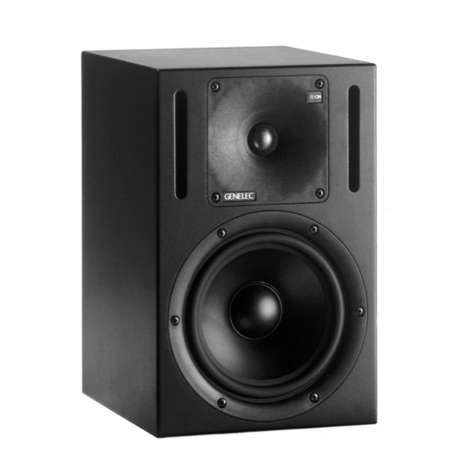
Genelec
Genelec 1030A User manual
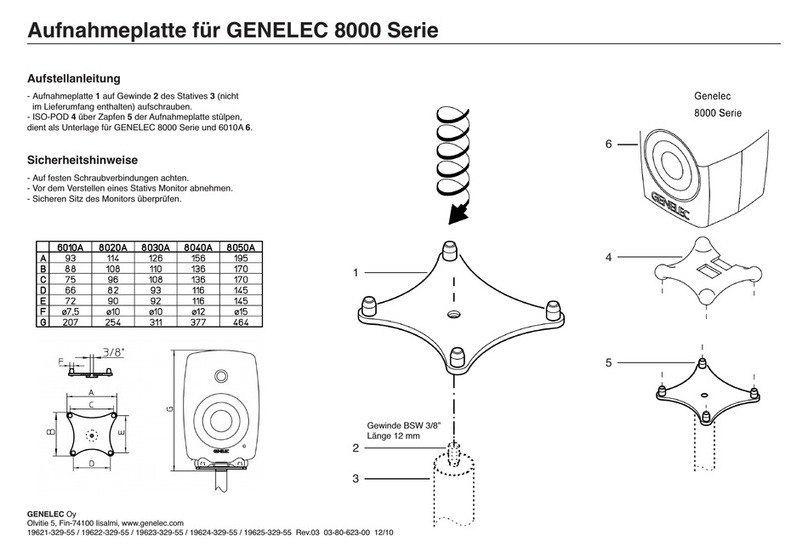
Genelec
Genelec 8000 Series User guide
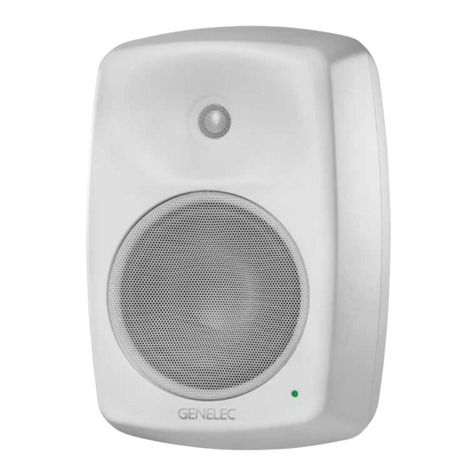
Genelec
Genelec 4040A User manual
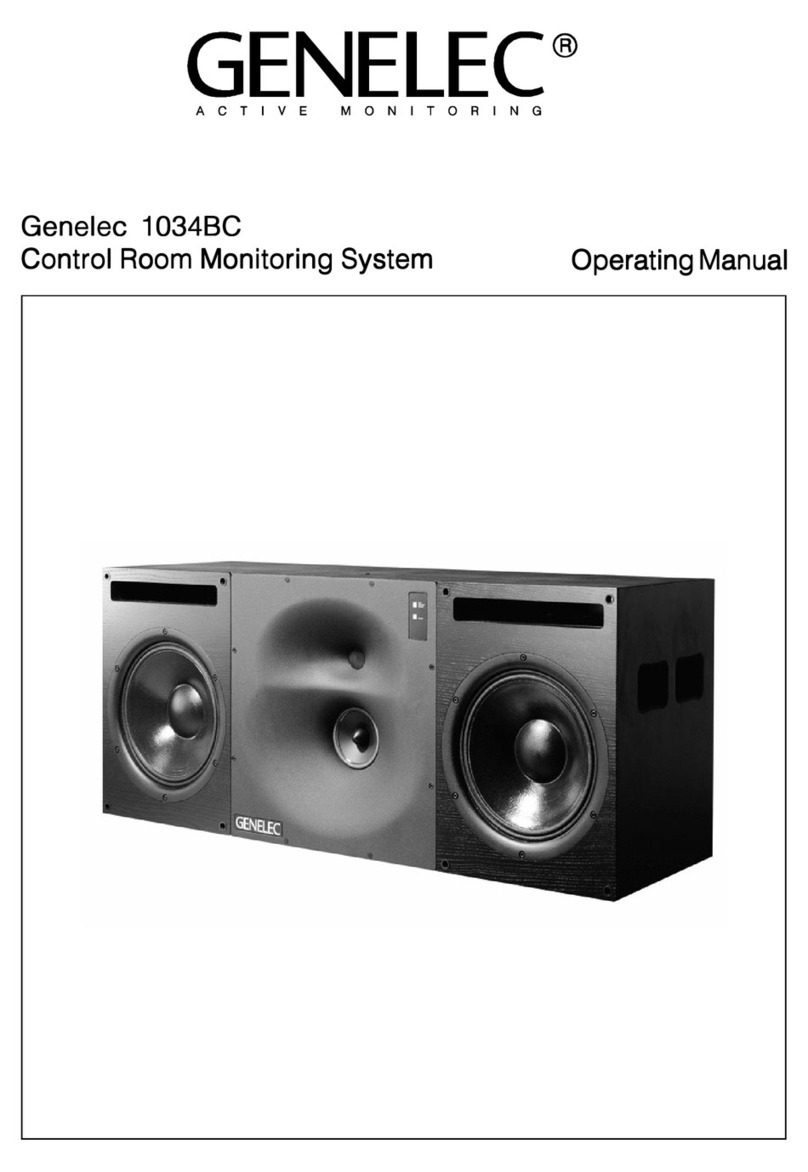
Genelec
Genelec 1034BC User manual
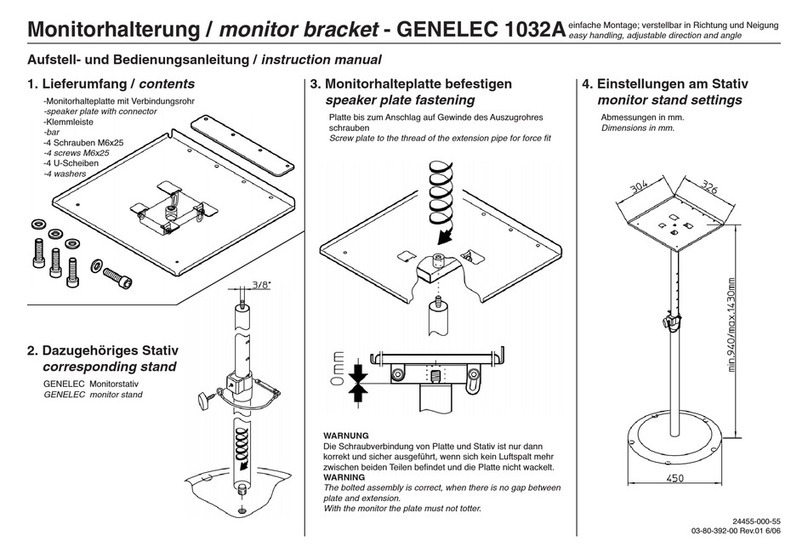
Genelec
Genelec 1032A User manual
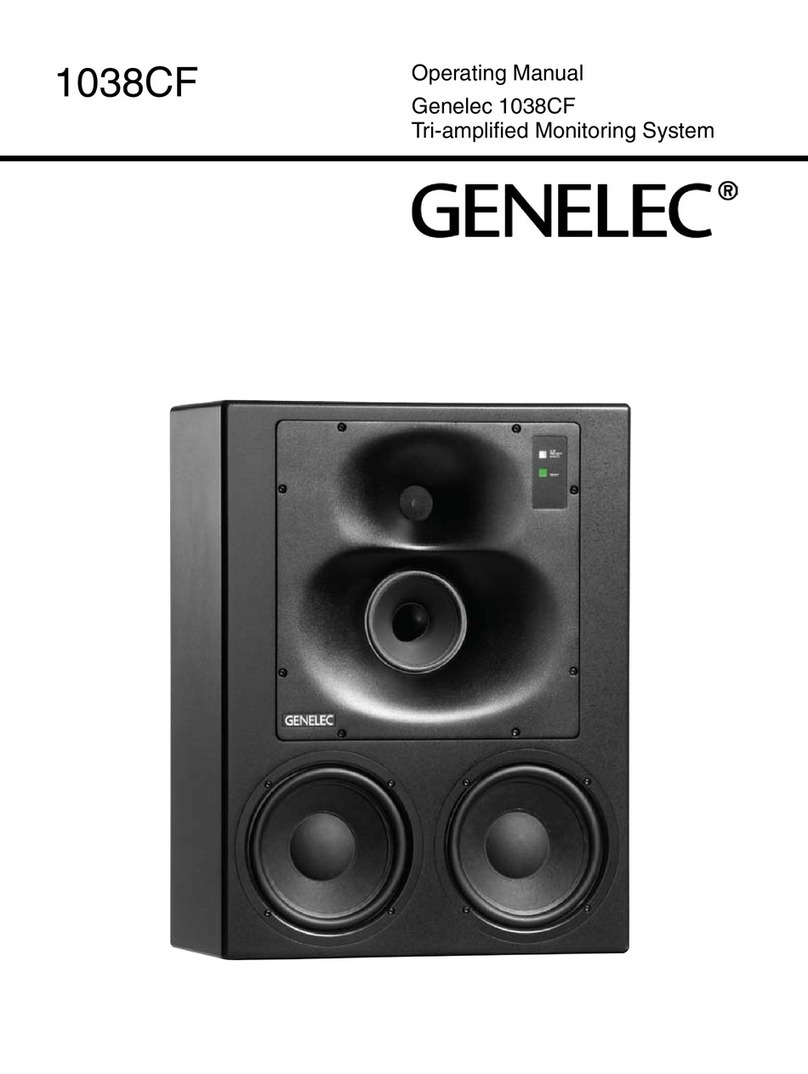
Genelec
Genelec 1038CF User manual
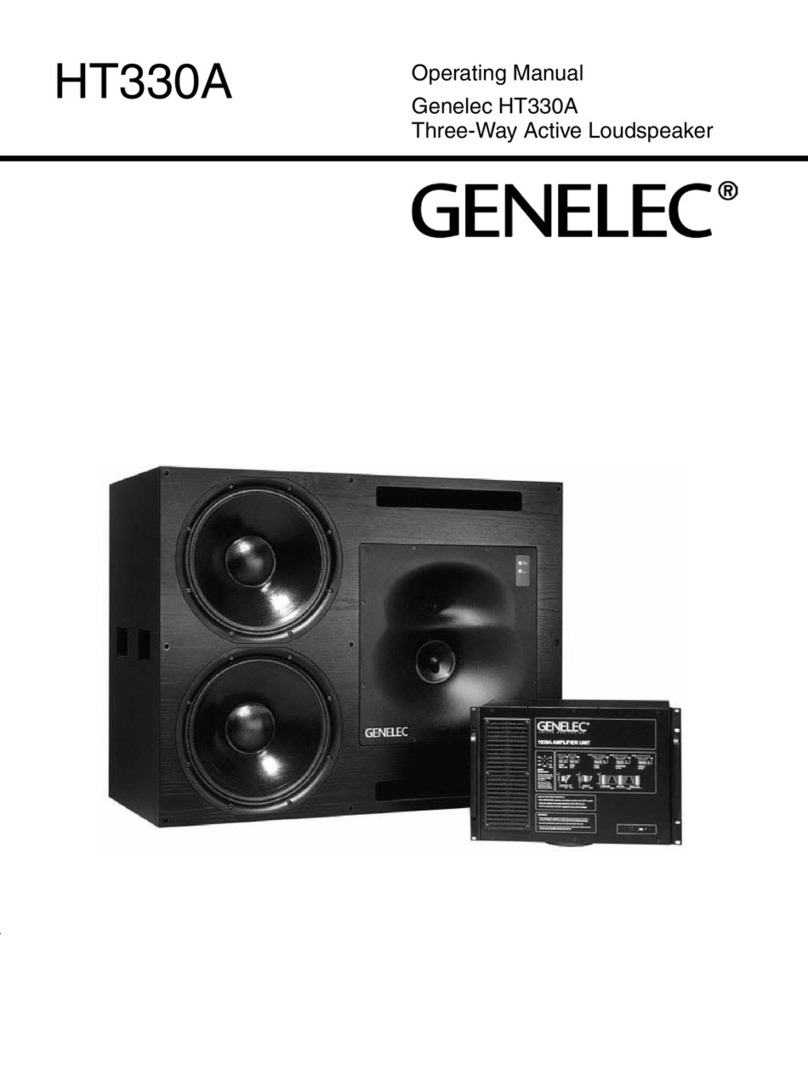
Genelec
Genelec HT330A User manual
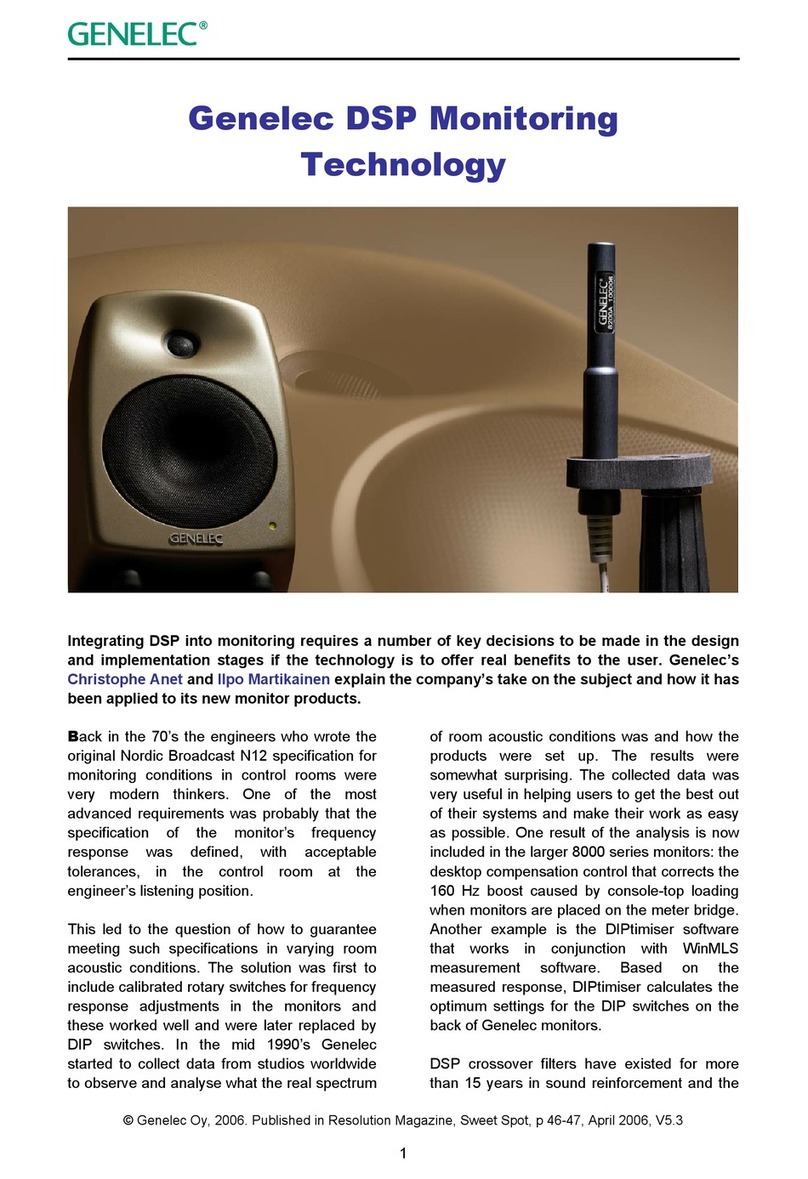
Genelec
Genelec DSP Monitoring User manual
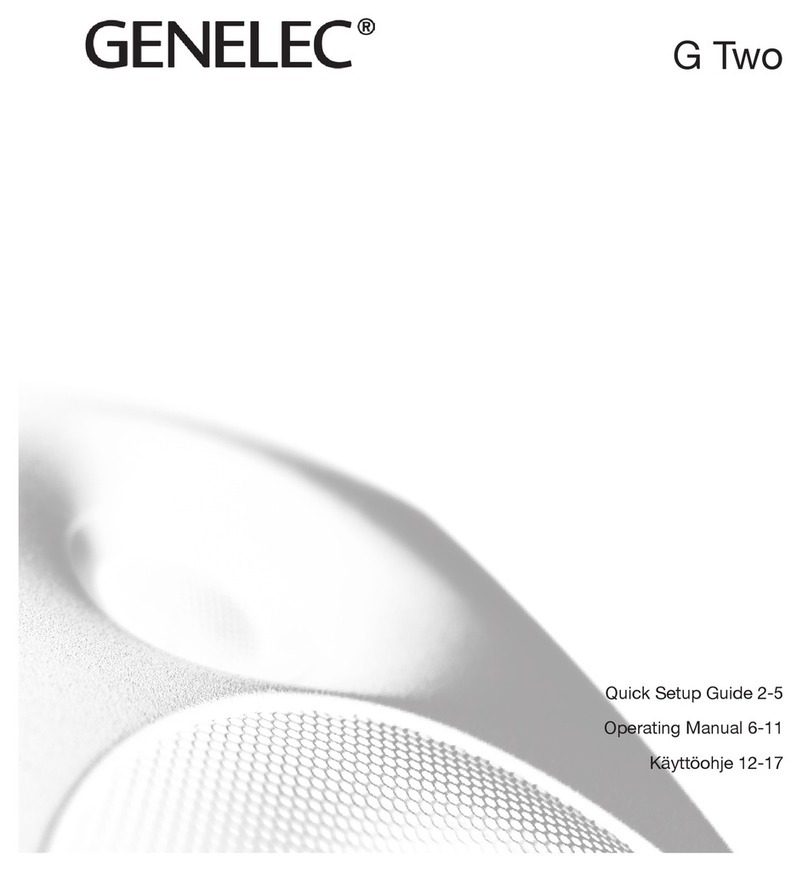
Genelec
Genelec G Two User manual
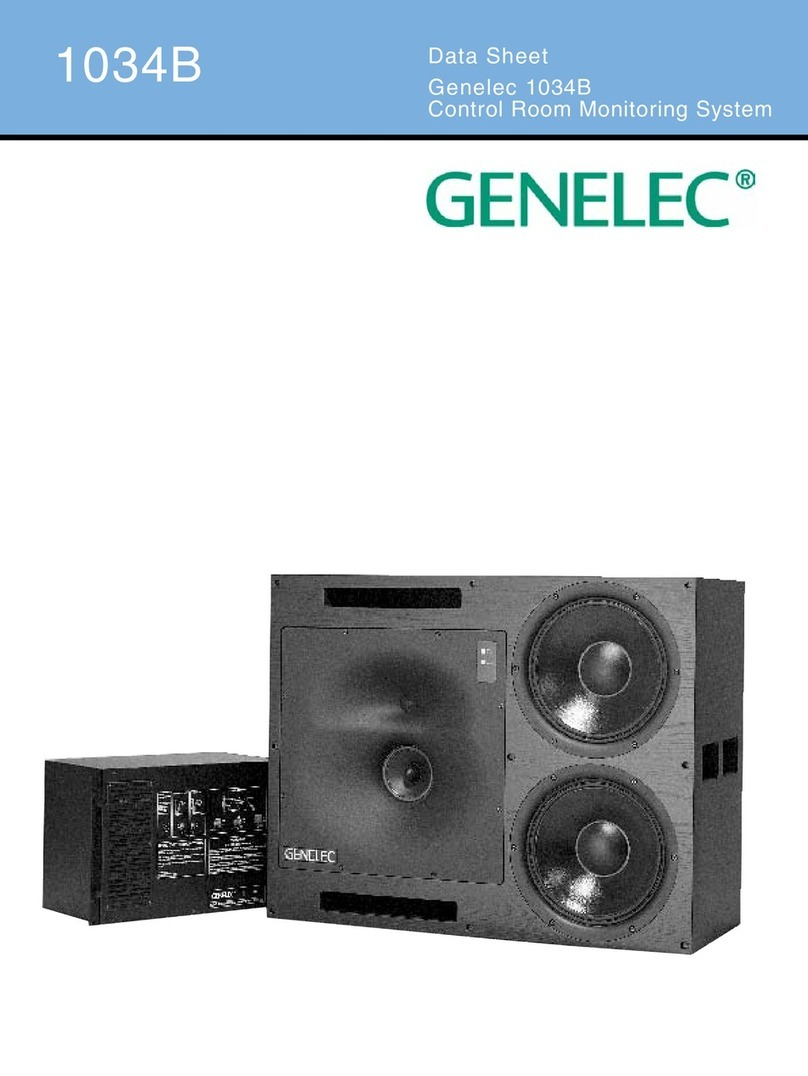
Genelec
Genelec 1034B User manual
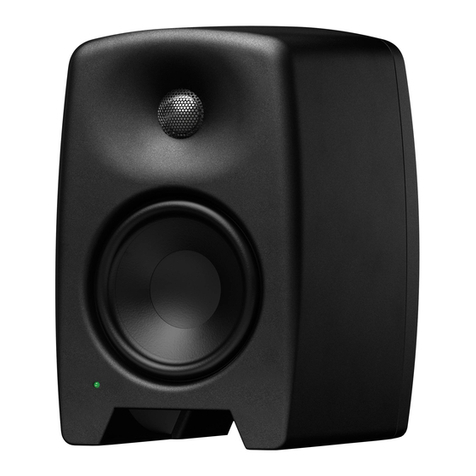
Genelec
Genelec M030 User manual
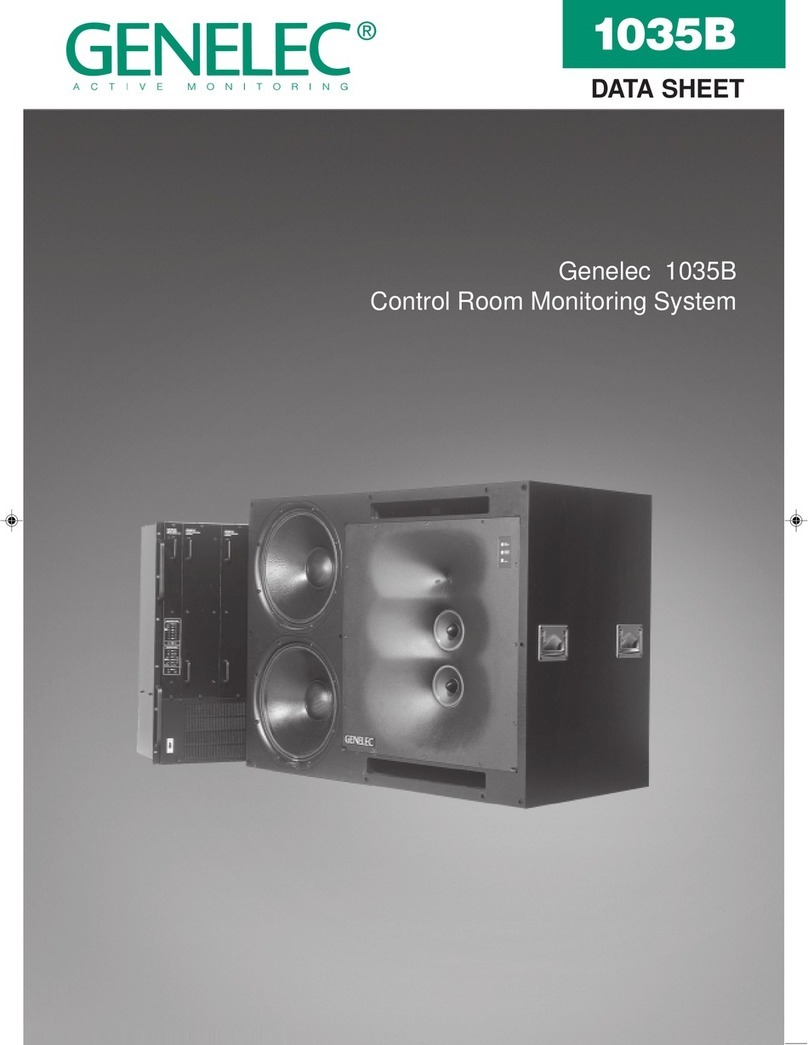
Genelec
Genelec 1035B User manual
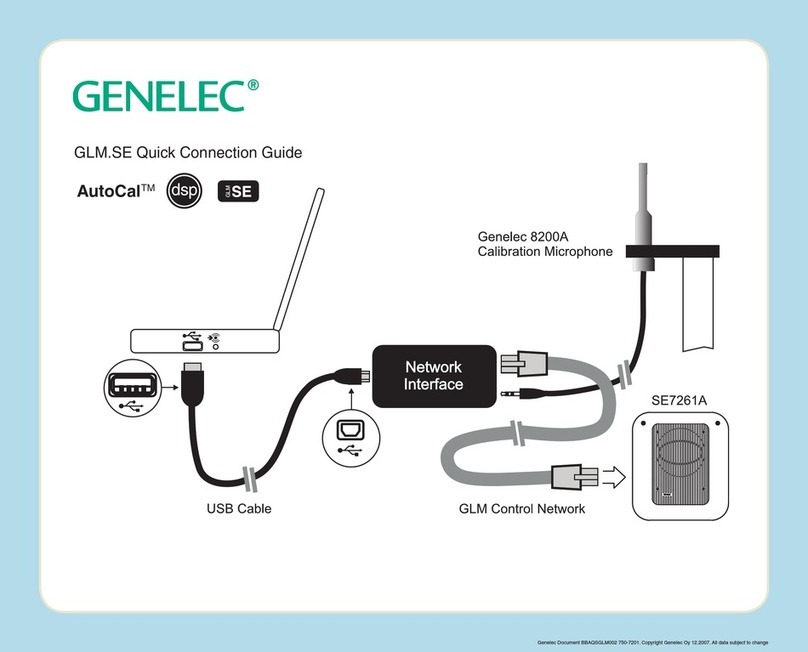
Genelec
Genelec GLM.SE Instruction Manual
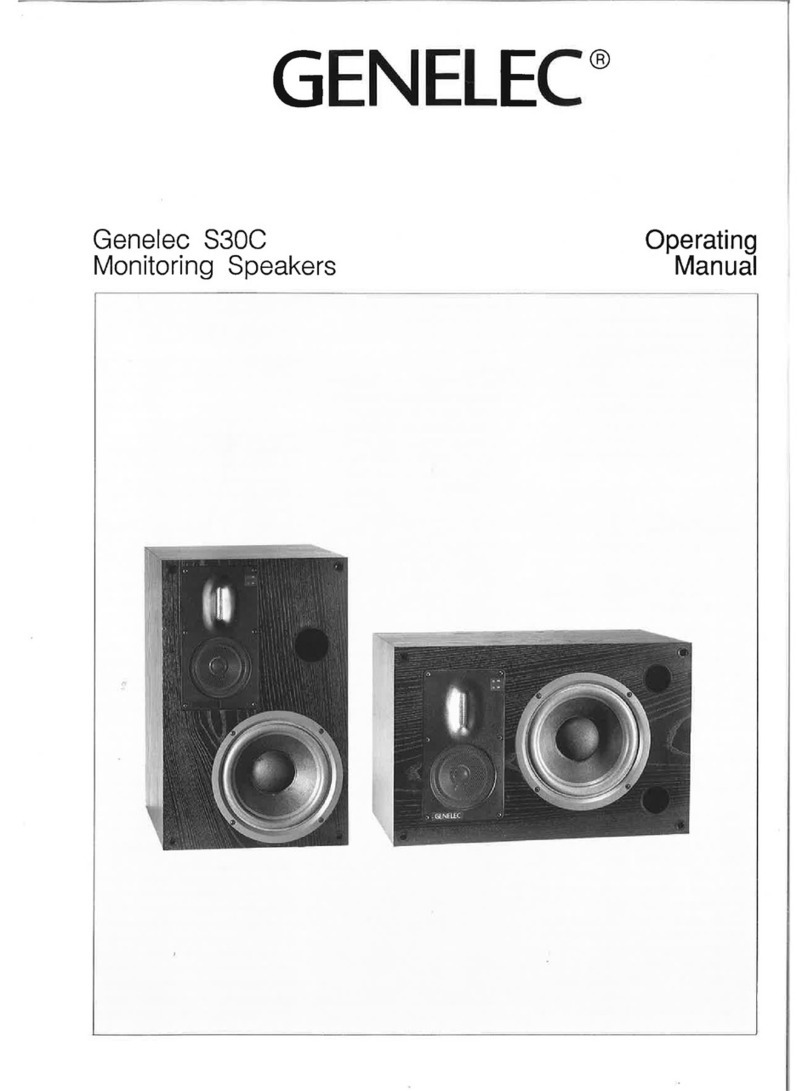
Genelec
Genelec S30C User manual
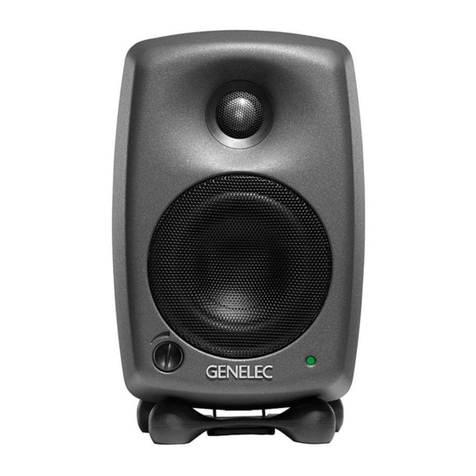
Genelec
Genelec 8020C User manual
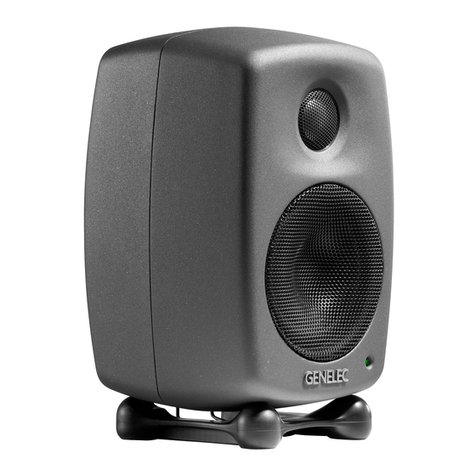
Genelec
Genelec 8010A User manual
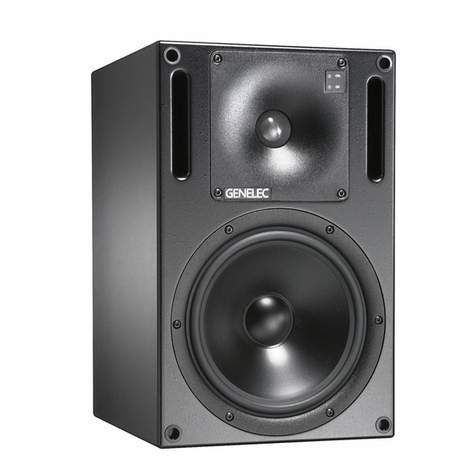
Genelec
Genelec 1031A User manual

Genelec
Genelec 8020A User manual

Genelec
Genelec 8260A User manual
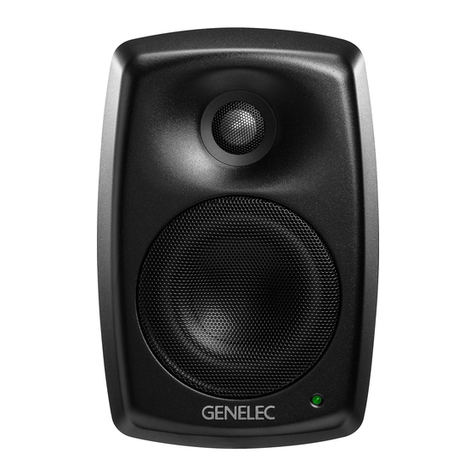
Genelec
Genelec 4420A User manual



